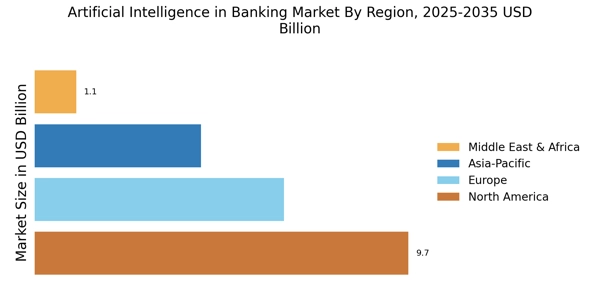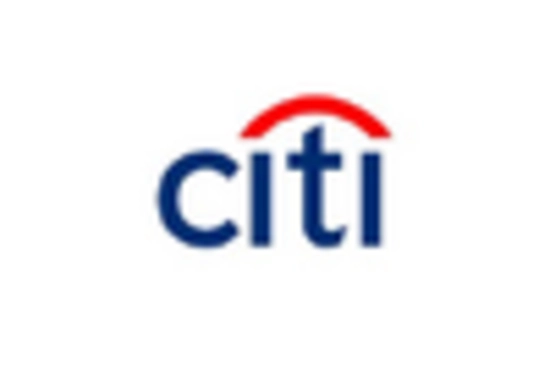The Artificial Intelligence in Banking Market is currently characterized by a dynamic competitive landscape, driven by rapid technological advancements and an increasing demand for enhanced customer experiences. Major players such as JPMorgan Chase (US), Bank of America (US), and HSBC (GB) are at the forefront, leveraging AI to optimize operations, improve risk management, and personalize services. These institutions are strategically positioned to capitalize on the growing trend of digital transformation, with a focus on integrating AI into their core banking functions. Their collective efforts not only enhance operational efficiency but also reshape customer interactions, thereby intensifying competition within the sector.
In terms of business tactics, key players are increasingly localizing their operations and optimizing supply chains to better serve diverse markets. The competitive structure of the Artificial Intelligence in Banking Market appears moderately fragmented, with a mix of established banks and emerging fintech companies vying for market share. This fragmentation is indicative of a landscape where innovation and agility are paramount, allowing companies to respond swiftly to changing consumer demands and regulatory environments.
In September 2025, JPMorgan Chase (US) announced a partnership with a leading AI technology firm to develop advanced predictive analytics tools aimed at enhancing fraud detection capabilities. This strategic move underscores the bank's commitment to leveraging AI for risk mitigation, potentially setting a new standard for security in banking operations. By integrating these sophisticated tools, JPMorgan Chase not only fortifies its defenses against fraud but also enhances customer trust, which is crucial in today’s digital banking environment.
Similarly, in August 2025, Bank of America (US) launched an AI-driven virtual assistant designed to provide personalized financial advice to customers. This initiative reflects the bank's focus on customer-centric innovation, aiming to improve user engagement and satisfaction. The introduction of such technology may significantly differentiate Bank of America in a crowded marketplace, as it aligns with the growing consumer preference for tailored financial solutions.
In July 2025, HSBC (GB) expanded its AI capabilities by acquiring a fintech startup specializing in machine learning algorithms for credit scoring. This acquisition is indicative of HSBC's strategy to enhance its lending processes and improve decision-making efficiency. By integrating cutting-edge technology into its operations, HSBC positions itself to better assess credit risk, thereby potentially increasing its market share in the competitive lending landscape.
As of October 2025, the prevailing trends in the Artificial Intelligence in Banking Market include a pronounced emphasis on digitalization, sustainability, and the integration of AI across various banking functions. Strategic alliances are increasingly shaping the competitive landscape, enabling firms to pool resources and expertise to drive innovation. Looking ahead, it appears that competitive differentiation will evolve from traditional price-based strategies to a focus on technological innovation, customer experience, and supply chain reliability, suggesting a transformative shift in how banks operate and compete in the future.


















Leave a Comment